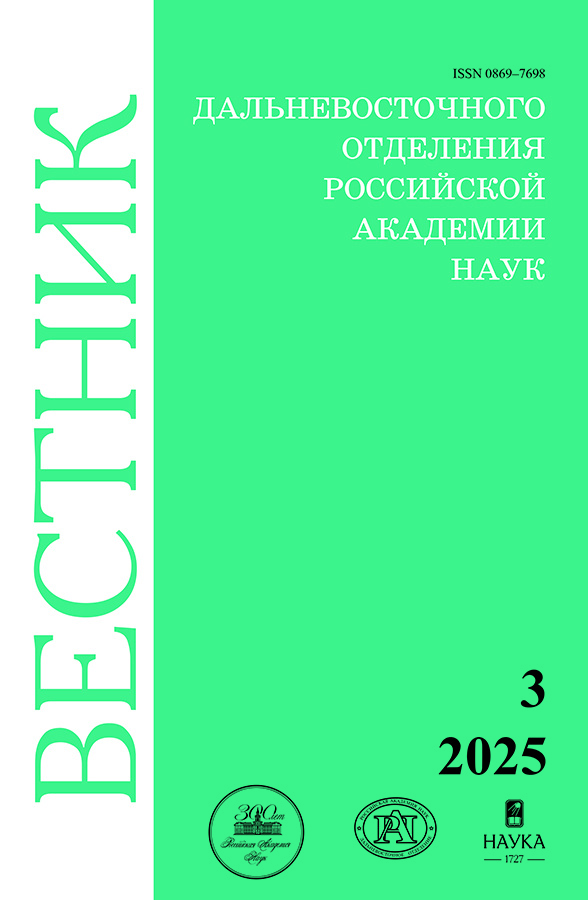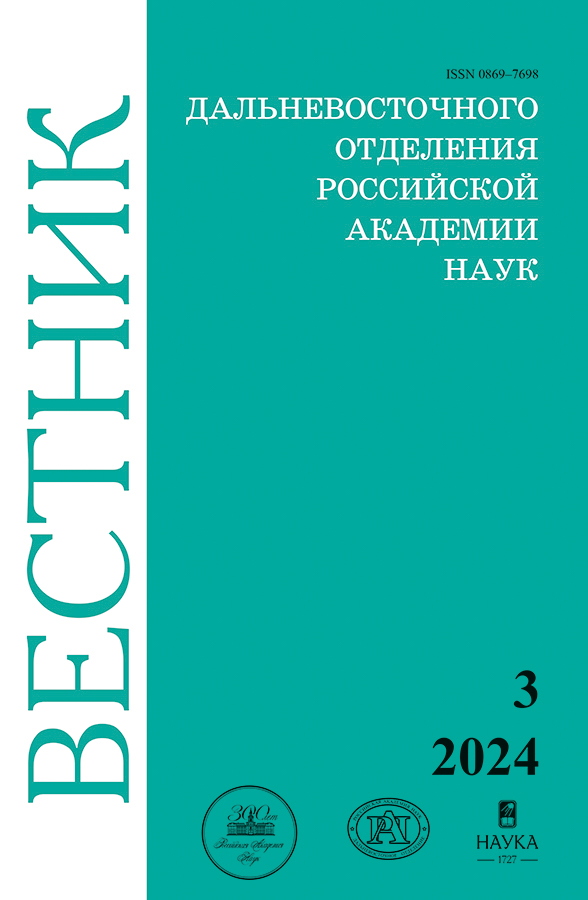Brown algae Costaria costata is a promising source of nutrients and biologically active compounds
- Authors: Imbs T.I.1, Malyarenko O.S.1, Bakunina I.Y.1, Schevchenko N.M.1, Suris V.V.1, Ermakova S.P.1
-
Affiliations:
- G.B. Elyakov Pacific Institute of Bioorganic Chemistry, FEB RAS
- Issue: No 3 (2024)
- Pages: 57-68
- Section: Chemical Sciences. Bioorganic chemistry
- URL: https://permmedjournal.ru/0869-7698/article/view/676049
- DOI: https://doi.org/10.31857/S0869769824030034
- EDN: https://elibrary.ru/ISRZHA
- ID: 676049
Cite item
Full Text
Abstract
Brown algae are a rich source of essential nutrients, including carbohydrates, proteins, minerals, polyunsaturated lipids, as well as a number of other health-promoting compounds that can act on a wide range of diseases. An overview is presented of the chemical composition of the brown algae Costaria costata, the biological activity of the polysaccharide fucoidan and phlorotannin isolated from it – compounds characteristic only of brown algae, as well as the effects associated with their consumption.
Keywords
Full Text
About the authors
Tatyana I. Imbs
G.B. Elyakov Pacific Institute of Bioorganic Chemistry, FEB RAS
Author for correspondence.
Email: tatyanaimbs@mail.ru
Candidate of Sciences in Chemistry, Senior Researcher
Russian Federation, VladivostokOlesya S. Malyarenko
G.B. Elyakov Pacific Institute of Bioorganic Chemistry, FEB RAS
Email: malyarenko.os@gmail.com
ORCID iD: 0000-0002-3262-0373
Candidate of Sciences in Chemistry, Senior Researcher
Russian Federation, VladivostokIrina Yu. Bakunina
G.B. Elyakov Pacific Institute of Bioorganic Chemistry, FEB RAS
Email: bakun@list.ru
ORCID iD: 0000-0003-4039-5927
Doctor of Sciences in Chemistry, Leading Researcher
Russian Federation, VladivostokNatalia M. Schevchenko
G.B. Elyakov Pacific Institute of Bioorganic Chemistry, FEB RAS
Email: natalyshe@piboc.dvo.ru
ORCID iD: 0000-0003-4780-835X
Candidate of Sciences in Chemistry, Senior Researcher
Russian Federation, VladivostokValery V. Suris
G.B. Elyakov Pacific Institute of Bioorganic Chemistry, FEB RAS
Email: suritsw@yandex.ru
ORCID iD: 0009-0002-6585-2506
Junior Researcher
Russian Federation, VladivostokSvetlana P. Ermakova
G.B. Elyakov Pacific Institute of Bioorganic Chemistry, FEB RAS
Email: swsetlana_e@mail.ru
ORCID iD: 0000-0002-5905-2046
Doctor of Sciences in Chemistry, Associate Professor, Head of the Laboratory
Russian Federation, VladivostokReferences
- Cardoso S. M., Pereira O. R., Seca A. M.L., Pinto D. C.G.A., Silva A. M.S. Seaweeds as preventive agents for cardiovascular diseases: From nutrients to functional foods. Marine Drugs. 2015;13:6838–6865.
- Belous O. S., Titlyanova T. V., Titlyanov E. Ya. Morskie rasteniya bukhty Troitsy i smezhnykh akvatorii (zaliv Petra Velikogo, Yaponskoe more) = [Marine plants of Troitsy Bay and adjacent water areas (Peter the Great Bay, Sea of Japan)]. Vladivostok: Dal’nauka; 2013. 264 p. (In Russ.).
- Denisova A. V., Krupnova T. N. Perspektivy kul’tivirovaniya kostarii rebristoi (Costaria costata) = [Prospects for cultivating Costaria costata]. Tezisy dokladov chetvertoi mezhdunarodnoi nauchno-prakticheskoi konferentsii «Morskie pribrezhnye ehkosistemy. Vodorosli, bespozvonochnye i produkty ikh pererabotki», Yuzhno-Sakhalinsk, 19–22 sentyabrya 2011 = [Abstracts of reports of the fourth international scientific and practical conference Marine coastal ecosystems. Algae, invertebrates and their products. Yuzhno-Sakhalinsk, 2011, 19–22 september]. Yuzhno-Sakhalinsk; 2011. P. 176–177. (In Russ.).
- Sukhoveeva M. V., Podkorytova A. V. Promyslovye vodorosli i travy morei Dal’nego Vostoka: biologiya, raspredelenie, zapasy, tekhnologiya pererabotki = [Commercial algae and grasses of the seas of the Far East: biology, distribution, reserves, processing technology]. Vladivostok: TINRO-Tsentr; 2006. 244 p. (In Russ.).
- Dawczynski C., Schubert R., Jahreis G. Amino acids, fatty acids, and dietary fiber in edible seaweed products. Food Chemistry. 2007;103:891–899.
- Patarra R. F., Paiva L., Neto A. I. et al. Nutritional value of selected macroalgae. Journal of Applied Phycology. 2011;23:205–208.
- Imbs T. I., Shevchenko N. M., Sukhoverkhov S. V. et al. Seasonal variations of the composition and structural characteristics of polysaccharides from the brown alga Costaria costata. Chemistry of Natural Compounds. 2009;45(6):786–791.
- Deniaud-Bouët E., Kervarec N., Michel G. et al. Chemical and enzymatic fractionation of cell walls from Fucales: Insights into the structure of the extracellular matrix of brown algae. Annals of Botany. 2014;114:1203–1216.
- Usov A. I., Kosheleva E. A., Yakovlev A. P. Polysacharide composition of several brown algae of the Japan Sea. Bioorganicheskaya Khimiya. 1985;11(6):830–836. (In Russ.).
- Imbs T. I., Krasovskaya N. P., Ermakova S. P. et al. Comparative study of chemical composition and antitumor activity of aqueous-ethanol extracts of brown algae Laminaria cichorioides, Costaria costata, and Fucus evanescens. Russian Journal of Marine Biology. 2009;35(2):164–170.
- Imbs T. I. Polisakharidy i nizkomolekulyarnye metabolity nekotorykh massovykh vidov burykh vodoroslei morei Dal’nego Vostoka Rossii. Sposob kompleksnoi pererabotki vodoroslei: dis. kand. khim. nauk (dissertatsiya kandidata khimicheskikh nauk) = [Polysaccharides and low-molecular metabolites of some common species of brown algae in the seas of the Russian Far East. Method for complex processing of algae: dissertation of a Candidate of Chemical Sciences] / PIBOC. Vladivostok; 2010. 122 p. (In Russ.).
- Anastyuk S. D., Shevchenko N. M., Nazarenko E. L. et al. Structural analysis of a highly sulfated fucan from the brown alga Laminaria cichorioides by tandem MALDI and ESI mass spectrometry. Carbohydrate Research. 2010;345(15):2206–2212.
- Bilan M. I., Grachev A. A., Shashkov,A.S., Kelly M. et al. Further studies on the composition and structure of a fucoidan preparation from the brown alga Saccharina latissima. Carbohydrate Research. 2010;345(14):2038–2047.
- Cumashi A., Ushakova N. A., Preobrazhenslaya N. E., D’Incecco A. et al. A comparative study of the anti-inflammatory, anticoagulant, antiangiogenic, and antiadhesive activities of nine different fucoidans from brown seaweeds. Glycobiology. 2007;17:541–552.
- Anastyuk S. D., Imbs T. I., Shevchenko N. M. et al. ESIMS analysis of fucoidan preparations from Costaria costata, extracted from alga at different life-stages. Carbohydrate Polymers. 2012;90:993–1002.
- Ermakova S. P., Sokolova R. V., Kim S.-M. et al. Fucoidan from brown seaweeds Sargassum hornery, Eclonia cava, Costaria costata structural characteristics and anticancer activity. Applied Biochemistry and Biotechnology. 2011;164:841–850.
- Moon H. J., Park K. S., Ku M. J. et al. Effect of Costaria costata fucoidan on expression of matrix metalloproteinase-1 promoter, mRNA, and protein. Journal of Natural Products. 2009;72:1731–1734.
- Prokofjeva M. M., Imbs T. I., Shevchenko N. M. et al. Fucoidans as Potential Inhibitors of HIV-1. Marine Drugs. 2013;11(8):3000–3014.
- Makarenkova I. D., Leonova G. N., Maystrovkaya O. S. et al. Antiviral effect of brown algae-derived sulphated polysaccharides in case of experimental tick-borne encephalitis: tying structure and function. Рacific Medical Journal. 2012;1:44–46. (In Russ.).
- Martínez J. H.I., Castañeda H. G.T. Preparation and chromatographic analysis of phlorotannins. Journal of Chromatographic Science. 2013;51:825–838.
- Ragan M. A., Glombitza K. W. Phlorotannins, brown algal polyphenols. Progress in Phycological Research. 1986;4:129–241.
- Imbs T. I., Zvyagintseva T. N. Phlorotannins are polyphenolic metabolites of brown algae. Russian Journal of Marine Biology. 2018;44(4):217–227. (In Russ.).
- Tierney M. S., Soler-Vila A., Rai D. K. et al. UPLC-MS profiling of low molecular weight phlorotannin polymers in Ascophyllum nodosum, Pelvetia canaliculata and Fucus spiralis. Metabolomics. 2014;10:524–535.
- Silchenko A. S., Imbs T. I., Zvyagintseva T. N. et al. Brown alga metabolites – inhibitors of marine organism fucoidan hydrolases. Chemistry of Natural Compounds. 2017;53:345–350.
- Ferreres F., Lopes G., Gil-Izquierdo A. et al. Phlorotannin еxtracts from Fucales сharacterized by HPLC-DAD-ESI–MSn: approaches to hyaluronidase inhibitory capacity and antioxidant properties. Marine Drugs. 2012;10:2766–2781.
- Tierney M. S., Smyth T. J., Rai D. K. et al. Enrichment of polyphenol contents and antioxidant activities of Irish brown macroalgae using food-friendly techniques based on polarity and molecular size. Food Chemistry. 2013;139:753–761.
- Krentz A. J., Bailey C. J. Oral antidiabetic agents: current role in type 2 diabetes mellitus. Drugs. 2005;65:385–411.
- Yoon N. Y., Lee S.-H., Yong-Li, Kim S.-K. Phlorotannins from Ishige okamurae and their acetyl and butyrylcholinesterase inhibitory effects. Journal of Functional Foods. 2009;1:331–335.
- Shibata T., Fujimoto K., Nagayama K. et al. Inhibitory activity of brown algal phlorotannins against hyaluronidase. International Journal of Food Science and Technology. 2002;37:703–709.
- Imbs T. I., Silchenko A. S., Fedoreev S. A., et al. Fucoidanase inhibitory activity of phlorotannins from brown algae. Algal Research. 2018;32:54–59.
- Malyarenko O. S., Imbs T. I., Ermakova S. P. In vitro anticancer and radiosensitizing activities of phlorethols from the brown alga Costaria costata. Molecules. 2020;25:115–122. 3208.
- Bakunina I., Imbs T., Likhatskaya G. et al. Effect of phlorotannins from brown algae Costaria costata on α-N-acetylgalactosaminidase produced by duodenal adenocarcinoma and melanoma cells. Marine Drugs. 2023;21(33):1–18.
- Holdt S. L., Kraan S. Bioactive compounds in seaweed: Functional food applications and legislation. Journal of Applied Phycology. 2011;23:543–597.
- Ninomiya K. Science of umami taste: Adaptation to gastronomic culture. Flavour. 2015;4:13.
- Khotimchenko S. V. Lipidy morskikh vodoroslei-makrofitov i trav. Struktura, raspredelenie, analiz = [Lipids from macrophyte seaweeds and herbs. Structure, distribution, analysis]. Vladivostok: Dal’nauka; 2003. 234 p. (In Russ.).
- Nelson M. M., Phleger C. F., Nichols P. D. Seasonal lipid composition in macroalgae of the northeastern Pacific Ocean. Botanica Marina. 2002;45:58–65.
- Pereira H., Barreira L., Figueiredo F. et al. Polyunsaturated fatty acids of marine macroalgae: Potential for nutritional and pharmaceutical applications. Marine Drugs. 2012;10:1920–1935.
- Simopoulos A. P. The importance of the ratio of omega-6/omega-3 essential fatty acids. Biomedicine and Pharmacotherapy. 2002;56:365–379.
- Simopoulos A. The importance of the omega-6 /omega-3 fatty acid ratio in cardiovascular disease and other chronic diseases. Experimental Biology and Medicine. 2008;233:674–688.
- Gerasimenko N. I., Busarova N. G., Moiseenko O. P. Seasonal changes in the content of lipids, fatty acids, and pigments in brown alga Costaria costat. Russian Journal of Plant Physiology. 2010;57(2):217–223. (In Russ.).
- Adrogué H. J., Madias N. E. The impact of sodium and potassium on hypertension risk. Seminars in Nephrology. 2014;34:257–272.
- Moro C. O., Basile G. Obesity and medicinal plants. Fitoterapia. 2000;71:S73–S82.
- Küpper F. C., Feiters M. C., Olofsson B., et al. Commemorating two centuries of iodine research: An interdisciplinary overview of current research. Angewandte Chemie International Edition. 2011;50:11598–11620.
Supplementary files






